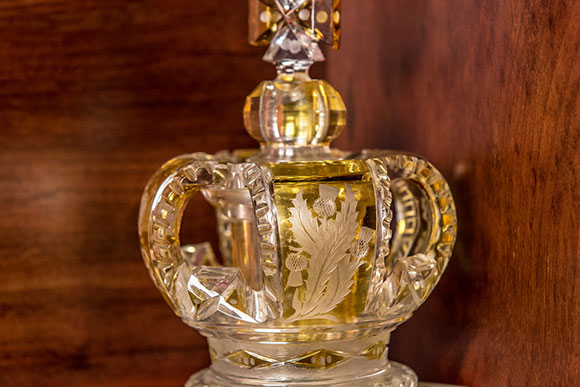Apsley Pellatt and Co, C1830
Dimensions: 10cm high
Material: Glass
To listen to the audio description of this object either click the object audio MP3 file below which will play it in your default audio player, or press the play button which you will find after the object audio MP3 file and this will play it from within the web page. The play button can also be used to pause the audio. This button is followed by the elapsed and remaining time, and a further button to mute the audio.
Queen Adelaide Perfume Bottle Audio MP3 File
This cut-glass, crown-shaped perfume bottle once belonged to Queen Adelaide, widow of King William IV, who moved into Bentley Priory in 1848, a year before she died in December 1849. Through her husband, Queen Adelaide was aunt to Queen Victoria.
The bottle is made from two types of glass – a yellow and a clear glass. The yellow glass forms the bulk of the design while the clear glass is used as edging decoration. The perfume bottle is mounted on a small stone plinth and the bottle itself is about ten centimetres high.
The perfume bottle is in the shape of the Royal Crown and is in three distinctive parts. There is a hollow, tubular receptacle in the centre. Around this are four arches, curving out from the base to the top, mimicking the arches of a crown. These arches meet at the top in the middle where there is a third element – a round globe with a Maltese cross on top which forms the stopper of the bottle. The Maltese cross is an eight pointed cross, with four arrow shaped arms pointing to a center. Etched on each of the arches are a thistle, shamrock and rose. On the fourth arch is the Queen’s Royal monogram, the initials ‘AR’ surmounted by her crown.
Queen Adelaide had a strong affection for Malta, which became part of the British Empire in 1814. During a visit in 1838, Queen Adelaide found that there was no place of Anglican worship on the island, and so commissioned the building of St Paul’s Pro-Cathedral.
The bottle was manufactured by British glassware company, Apsley Pellatt and Co, London, around 1830. King William IV acceded to the throne in 1830 and was crowned in 1831. It is likely that the perfume bottle was produced for the new Queen at this time.
 What’s On
What’s On Opening Hours & Admission
Opening Hours & Admission

